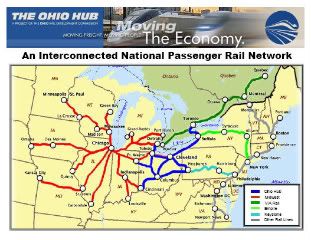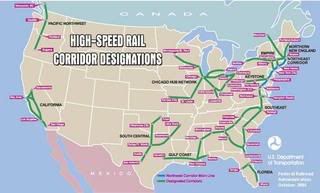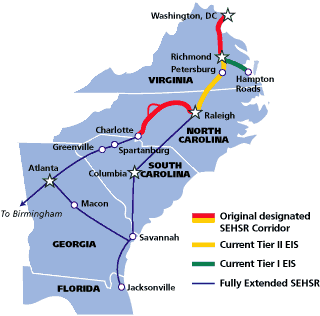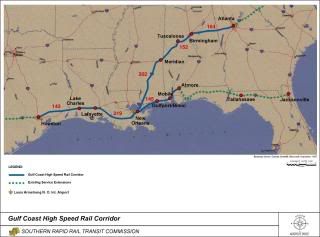(8 am. – promoted by ek hornbeck)
Burning the Midnight Oil for Energy Independence also in Orange
 For the last eight years, development of Energy Independent transport has been faced with a dog-in-the-manger administration fighting furiously to move forward into Cartopian vision of endless crude oil fueling endless road works so people can drive endless hours to actually get wherever they need to go to do whatever it is they need to do.
For the last eight years, development of Energy Independent transport has been faced with a dog-in-the-manger administration fighting furiously to move forward into Cartopian vision of endless crude oil fueling endless road works so people can drive endless hours to actually get wherever they need to go to do whatever it is they need to do.
However, there is hope. This year, the Amtrak funding bill included substantial funding for restoring the North East Corridor to an adequate state of repair. On November 4, California passed Proposition 1A, providing $9.95b in bonds for the California High Speed Rail (HSR) and connecting infrastructure. And then, on November 19, John Kerry and Arlen Specter introduced the a bill for funding High Speed Rail projects:
Titled the High-Speed Rail for America Act of 2008, the bill would provide money for tax-exempt bonds to finance long-stalled high-speed rail projects.
So let’s look at the projects that are on the drawing boards.
Bush Administration obstructionism has prevented breaking ground on a number of projects. Still, the case for progress toward a 21st century transportation system is compelling, and so all across the country, planning and other preliminary work has proceeded.
In Part I, I looked at a nationwide electric rail grid, supporting two classes of rail … regular bulk freight rail, and “Rapid Rail”. However, the most impressive recent progress has been toward funding the next step up from Rapid Rail.
This is true High Speed Rail … Proposition 1A started the funding for one in California (first clip), following a broad range of experience with successful High Speed Rail projects around the world (second clip) (NB. Yes, that’s a sales pitch in those clips):
In a sense, California’s geography and population distribution conspired to push it into a true HSR system. The two biggest population centers in the state, the LA basin and the Bay area, are 340 miles apart, line of sight, between four and five hundred miles along a transport corridor. The Central Valley to the Bay would have a hard time drawing enough passengers to pay for an effective passenger alignment between the two, and the same for the Central Valley to the LA Basin. Now, step up to true High Speed Rail, and include trips between LA and the Bay in under 2 hours, 40 minutes … running with a top speed of around 220mph to achieve an Effective Line of Sight speed of 125mph … and that is going to attract a noticeable share of a far larger transport market.

It seems that the other recipient for funding for the “very” High Speed Rail funding under Kerry-Spectre is the Northeast Corridor. The Acela tilt-train, a trainset that has a top speed of 200mph, already provides services between Washington DC and Boston.
However, when you look more closely at the Acela, that translates into the 225 mile journey from DC to New York in about 2:50 48 an average speed of 80mph … while the New York to Boston journey is about 3:40.
Effective HSR service is far less a matter of the top speed a train can achieve, and far more a matter of maintaining a higher overall rate of speed. After all, consider a route with two 100 miles sections, one traveled at 200mph and the other traveled at 50mph. The first section is completed in half an hour, the second in two hours, and the average speed is 80 mph. Double the speed of the high speed leg, and the trip is two and a quarter hours for an average speed of 89mph. Double the speed of the low speed leg, and the trip finished in 1 and a half hour, for an average speed of 133mph.
While the top speed of the trainset is 200mph, the top speed of the Acela in service is 150mph. Further, south of New York, the old overhead electric infrastructure limits the top speed of the service to 135mph. And in Connecticut north of New Haven, the limited separation between tracks prevents the Acela from using its tilting mechanism, which limits its top speed going around curves. So realignment that straightens out some of the Connecticut curves and upgrade of the overhead electric infrastructure south of New York will cut into trip times.
And even so … the Northeast Regional does DC to New York in 3:15 to 3:40. Cutting 25 to 50 minutes off the trip may not seem like a lot, but its worth a substantial increase in potential market share. NYC to Boston in 3:40 is not going to attract the same market share, but it is still a substantial transport market, and the benefit in cutting off the forty to sixty minutes from the Northeast Regional times of 4:20 to 4:40 is also substantial.
Extensive experience shows that a train trip of under 3 hours can hope to capture 40% of an existing air transport market, and one of two hours can hope to capture a dominant 70%. So investments into the Northeast Corridor to shave minutes at a time off of the Acela routes are an attractive proposition.
And, of Course, America Is Made for High Speed Rail
However, the Northeast Corridor and California are special cases. The Northeast Corridor is a special case because of the high average population density, so that it experiences very congested rail lines. This makes each ten minutes shaved off a rail route a cause for celebration. California is a special case because it is such an enormous state that it almost completely contains two distinct Megalopolitan complexes in Northern and Southern California, with their highest population centers separated by more than three hundred miles.
 For most of America, there is a much easier path ahead for High Speed Rail. We can put in place a network of Rapid Rail passenger systems, to provide a platform to build on. From there, we can follow the French strategy of building true High Speed Rail Corridors in stages, with HSR trainsets operating on a true HSR alignment as they are completed, then finishing the journey on the Rapid Rail network.
For most of America, there is a much easier path ahead for High Speed Rail. We can put in place a network of Rapid Rail passenger systems, to provide a platform to build on. From there, we can follow the French strategy of building true High Speed Rail Corridors in stages, with HSR trainsets operating on a true HSR alignment as they are completed, then finishing the journey on the Rapid Rail network.
The map above shows the already-designated “High Speed Rail” corridors. However, in US Legislative terminology, “High Speed Rail” is anything that can run above 90mph … so many of these corridors are in reality Rapid Rail corridors.
And the actual plans that are in progress, at various stages from the earliest planning stages to already proceeding with infrastructure improvements on existing lines while planning for system expansion, are far more extensive than the corridor designations in the US DoT map:
- The Midwest Interstate Passenger Rail Commission: the Midwest Hub
- The Ohio Rail Development Commission: The Ohio Hub
- The New York State Senate High Speed Rail Task Force
- Southeast High Speed Rail Corridor
- The Florida High Speed Rail Authority
- Southern High Speed Rail Commission
- The Texas High Speed Rail and Transportation Corporation: The T-bone Corridor
- Rocky Mountain Rail Authority (Colorado)
Some of these projects have been progressing slowly through planning and environmental impact studies, some have had a modicum of funding for modest infrastructure improvements, some were started up, reported, and then put into mothballs … but all represent a starting point for building up our Rapid Rail capabilities.




Linking Rapid Rail Together: Inter-urban Rail Coast to Coast
 Now, the first thing that jumps out from the High Speed Rail Corridor Map is the lack of a national network.
Now, the first thing that jumps out from the High Speed Rail Corridor Map is the lack of a national network.
Of course, that is standing on its own. Overlay the existing Amtrak route nastional structure on top of the High Speed and Rapid Rail Corridors, and the routes knit together into a single national grid.
And remember our platform from Part I. A program of electrifying the STRACNET for freight rail rolls out naturally into transcontinental electric passenger trains, with the exact same improvements that allow reliable high speed freight also providing a massive improvement in service level for Amtrak transcontinental trains.
So that is interconnection level one: the existing Amtrak system, including the route expansions and service improvements made possible as a side effect of the STRACNET electrification and High Speed Freight program.
Linking Rapid Rail Together: True High Speed Rail
Consider the Empire Corridor (New York) and Keystone Corridor (Pennsylvania), as they links together with the Ohio Hub, connecting on to the Midwest Hub centered on Chicago.
 Now, add a true High Speed Rail alignment, from New York through Northeast Ohio and Northern Indiana to Chicago. At present, that High Speed Rail corridor would connect New York and Chicago, as well as drawing from points in between along the rail corridor itself.
Now, add a true High Speed Rail alignment, from New York through Northeast Ohio and Northern Indiana to Chicago. At present, that High Speed Rail corridor would connect New York and Chicago, as well as drawing from points in between along the rail corridor itself.
However, if the Midwest Hub and Ohio Hubs are in place, that true HSR route would cast a much wider net. Running from Chicago on a HSR into northeast Ohio and then switching onto the Ohio Hub provides rapid Chicago / Pittsburgh and Chicago / Buffalo routes. Running from New York through to northeast Ohio and then switching onto the Ohio Hub brings New York / Columbus / Cincinnati and New York / Toledo / Detroit into the network.
The key, then, is to get viable regional Rapid Rail systems going as quickly as possible, and then use them as platforms to start the process of constructing the true HSR corridors that will turbocharge the trip possibilities.
Fast-Tracking Regional Rapid Rail
And Part I already laid out a process for fast-tracking Regional Rapid Rail. The electrification of STRACNET and investment in high speed freight capabilities is an urgent program in its own right. A major part of our nation’s structural addiction to oil is the fact that we cannot get important freight from coast to coast without relying on crude oil.
The electrification of STRACNET would mean, first, that existing rail traffic would not be threatened by an interruption of crude oil supplies.
Even more important, electrification of STRACNET by a public authority, funded by user fees, would substantially level the financial playing field between rail and the massively subsidized trucking industry. Under anything approaching a level playing field, some 50% to 80% of current ton-miles carried by trucks will shift to rail. That would mean a massive reduction in energy consumption per ton-mile, and a direct reduction in crude oil consumption.
That is the meat and potatoes of the electrification of STRACNET: a major step forward in national Energy Independence.
But at the same time, the program can easily contain a majority of the upgrades required to support passenger Rapid Rail – so the up-front capital cost of a passenger system would be cut substantially. Passenger trains would have to be acquired, stations built or rebuilt in appropriate locations, and rail routes built or upgraded through large urban areas to get to the central urban stations.
However, once the train is out into the Rapid Rail network, the same improvements that allow freight to pass through at 100mph with reliable delivery schedules allow 110mph passenger tilt-trains to pass through with reliable trip schedules.
So the electrification of STRACNET and establishment of Rapid Freight Rail is the foundation, and that foundation already supports substantially improvements to the existing passenger rail service. Then regional Rapid Passenger Rail is the ground floor, offering a large number of trips in the two and three hour range that is strongly competitive with air travel, and substantially shifting the margin of competition between rail travel and car travel. And then true HSR corridors leverage the Rapid Regional Rail systems and provide an even wider range of effective travel.
The Power and the Passion
There is an objection that is sure to be raised … since it was raised already in various quarters in response to the electrification of STRACNET itself. Where is the energy going to come from to power these trains? Are they, in fact, coal-burning trains, that rely on power lines to hide the coal out of sight and out of mind?
Ah, no, they are not. But that is the third piece of the puzzle, which is going to be picked up in Part 3.
| You Take All the Trouble that You Can Afford At Least You Won’t Have Time to Be Bored |

5 comments
Skip to comment form
Author
… back on track. Also at Progressive Blue and MLW.
And I want Detroit’s “big three” to build the cars, as a condition to the bridge loan they’re apparently going to be getting.